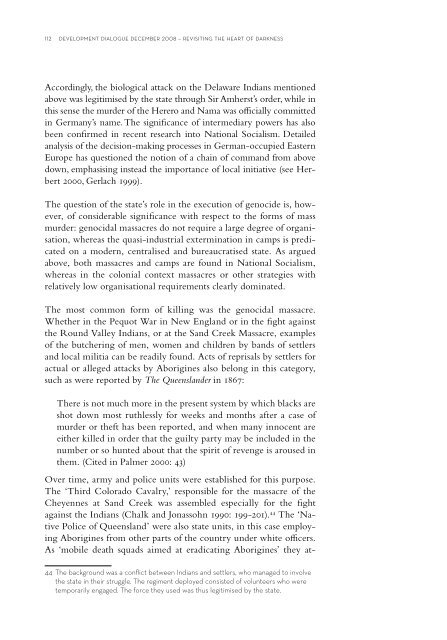60 years after the UN Convention - Dag Hammarskjöld Foundation
60 years after the UN Convention - Dag Hammarskjöld Foundation
60 years after the UN Convention - Dag Hammarskjöld Foundation
Create successful ePaper yourself
Turn your PDF publications into a flip-book with our unique Google optimized e-Paper software.
112 development dialogue december 2008 – revisiting <strong>the</strong> heart of darkness<br />
Accordingly, <strong>the</strong> biological attack on <strong>the</strong> Delaware Indians mentioned<br />
above was legitimised by <strong>the</strong> state through Sir Amherst’s order, while in<br />
this sense <strong>the</strong> murder of <strong>the</strong> Herero and Nama was offi cially committed<br />
in Germany’s name. The signifi cance of intermediary powers has also<br />
been confi rmed in recent research into National Socialism. Detailed<br />
analysis of <strong>the</strong> decision-making processes in German-occupied Eastern<br />
Europe has questioned <strong>the</strong> notion of a chain of command from above<br />
down, emphasising instead <strong>the</strong> importance of local initiative (see Herbert<br />
2000, Gerlach 1999).<br />
The question of <strong>the</strong> state’s role in <strong>the</strong> execution of genocide is, however,<br />
of considerable signifi cance with respect to <strong>the</strong> forms of mass<br />
murder: genocidal massacres do not require a large degree of organisation,<br />
whereas <strong>the</strong> quasi-industrial extermination in camps is predicated<br />
on a modern, centralised and bureaucratised state. As argued<br />
above, both massacres and camps are found in National Socialism,<br />
whereas in <strong>the</strong> colonial context massacres or o<strong>the</strong>r strategies with<br />
rela tively low organisational requirements clearly dominated.<br />
The most common form of killing was <strong>the</strong> genocidal massacre.<br />
Whe<strong>the</strong>r in <strong>the</strong> Pequot War in New England or in <strong>the</strong> fi ght against<br />
<strong>the</strong> Round Valley Indians, or at <strong>the</strong> Sand Creek Massacre, examples<br />
of <strong>the</strong> butchering of men, women and children by bands of settlers<br />
and local militia can be readily found. Acts of reprisals by settlers for<br />
actual or alleged attacks by Aborigines also belong in this category,<br />
such as were reported by The Queenslander in 1867:<br />
There is not much more in <strong>the</strong> present system by which blacks are<br />
shot down most ruthlessly for weeks and months <strong>after</strong> a case of<br />
murder or <strong>the</strong>ft has been reported, and when many innocent are<br />
ei<strong>the</strong>r killed in order that <strong>the</strong> guilty party may be included in <strong>the</strong><br />
number or so hunted about that <strong>the</strong> spirit of revenge is aroused in<br />
<strong>the</strong>m. (Cited in Palmer 2000: 43)<br />
Over time, army and police units were established for this purpose.<br />
The ‘Third Colorado Cavalry,’ responsible for <strong>the</strong> massacre of <strong>the</strong><br />
Cheyennes at Sand Creek was assembled especially for <strong>the</strong> fi ght<br />
against <strong>the</strong> Indians (Chalk and Jonassohn 1990: 199-201). 44 The ‘Native<br />
Police of Queensland’ were also state units, in this case employing<br />
Aborigines from o<strong>the</strong>r parts of <strong>the</strong> country under white offi cers.<br />
As ‘mobile death squads aimed at eradicating Aborigines’ <strong>the</strong>y at-<br />
44 The background was a confl ict between Indians and settlers, who managed to involve<br />
<strong>the</strong> state in <strong>the</strong>ir struggle. The regiment deployed consisted of volunteers who were<br />
temporarily engaged. The force <strong>the</strong>y used was thus legitimised by <strong>the</strong> state.

















